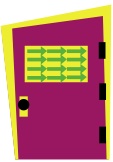Serendip is an independent site partnering with faculty at multiple colleges and universities around the world. Happy exploring!
The Three Doors of Serendip: Achieving Broader Understanding
|
The Three Doors of Serendip: Achieving Broader
Understanding
|
Door images from Woodstone |
Where we've gotten to is the idea that "broader" understanding is something that gets created from conflicting understandings, rather than something that exists prior to efforts to understand. Since there may be different conflicting understandings, both within and between individuals, there is no single path to broader understanding. Nor any single broader understanding to be reached. Let's though trace one path to a broader understanding in the case of the Three Door problem.
Let's suppose that your empirical, conscious understanding is that you should switch. That doesn't necessarily mean that all parts of you are entirely convinced of this. Part of you may still feel that the prize has an equal chance of being behind either door and it doesn't matter whether you switch or stay. Hence you have two conflicting understandings. How might you achieve a unified understanding?
Generalizing
One way you might do this is to explore how well the different understandings generalize to new situations. How about if there were four doors instead of three and Serendip opened two doors again leaving you with two doors to chose from? In this case, are you more inclined to believe in switching? Click the door below to try it out.
How about if the game starts with five doors? or six doors? or a hundred doors? Are you less conflicted about what to do if you see ninety-eight doors open before you decide whether to switch or stay? To think more about this, go here. This has the advantage that your understanding may be useful in cases other than the particular one being investigated, but also the problem that one may still not fully grasp why one understands the problem a particular way.
Itemizing
Another way to reach a broader understanding, in at least some situations where it is possible, is to literally enumerate all possible cases and the outcomes of each. This can in fact be done with the Three Doors Problem, as it can with for example the odds of winning with a particular poker hand. If you would like to see the problem worked out this way, go here. While this approach too can be generalized, it can get quite time consuming and may or may not actually yield any general insight. Furthermore, it works only in cases where all possible situations are actually enumerable. It's not a good route to understanding when things may happen that one hasn't entertained as possibilities.
Hunting the new
A third way to try to reach a broader understanding is more self-reflective. One starts with some existing understanding and a conflict between that and observations. One then tries to work out what the key elements of one's earlier understanding were and starts changing one or another of those elements to see whether a new understanding would result that accounts for the new observations. For an example of this in the case of the Three Doors Problem, go here.
|
Hands on understanding |
Experimental understanding |
 Broader understanding |





Comments
Interesting..
Interesting..
Post new comment